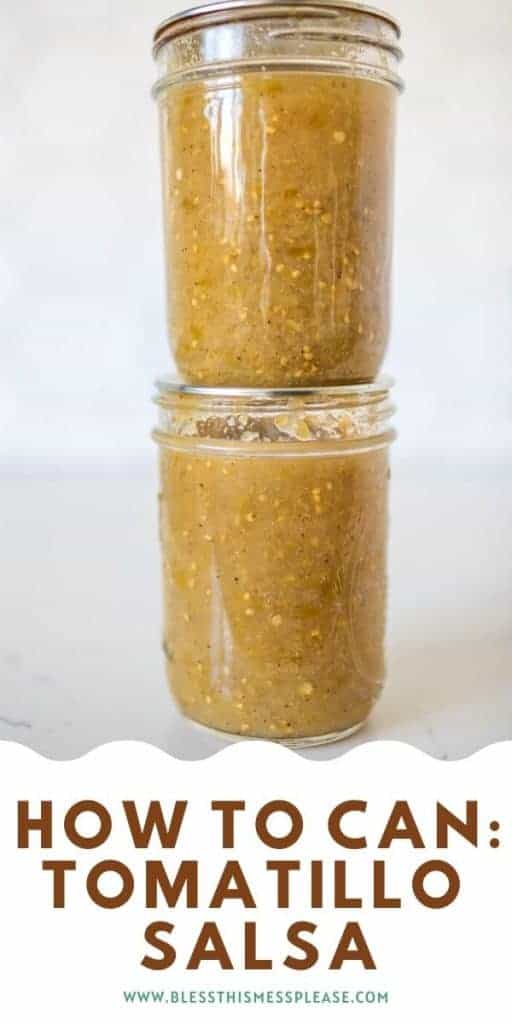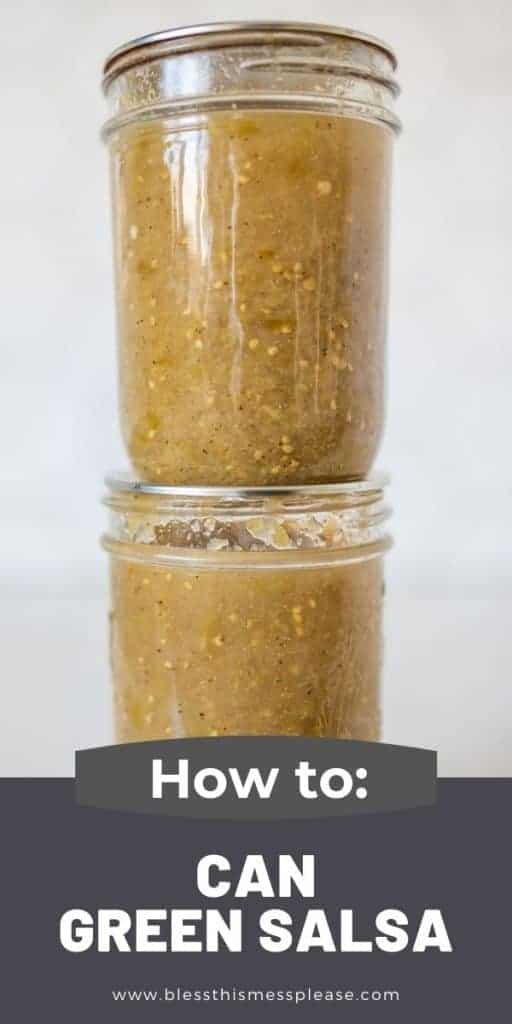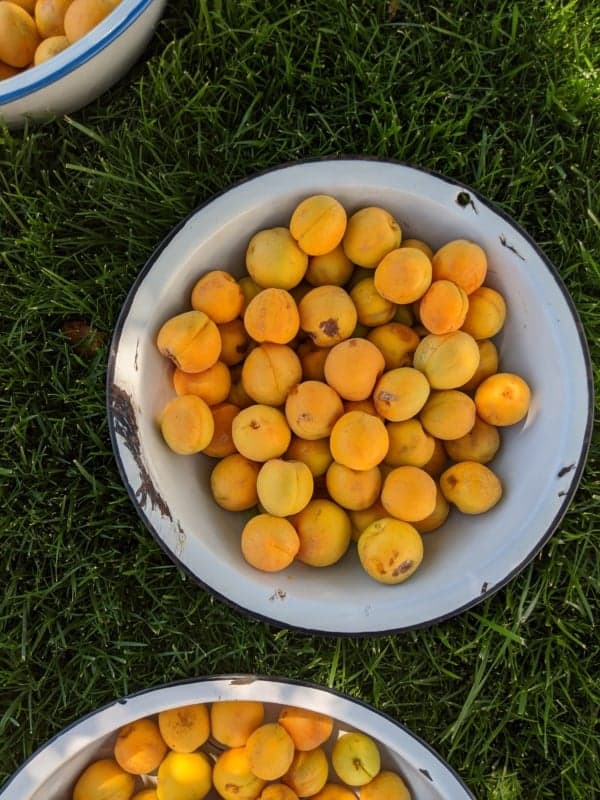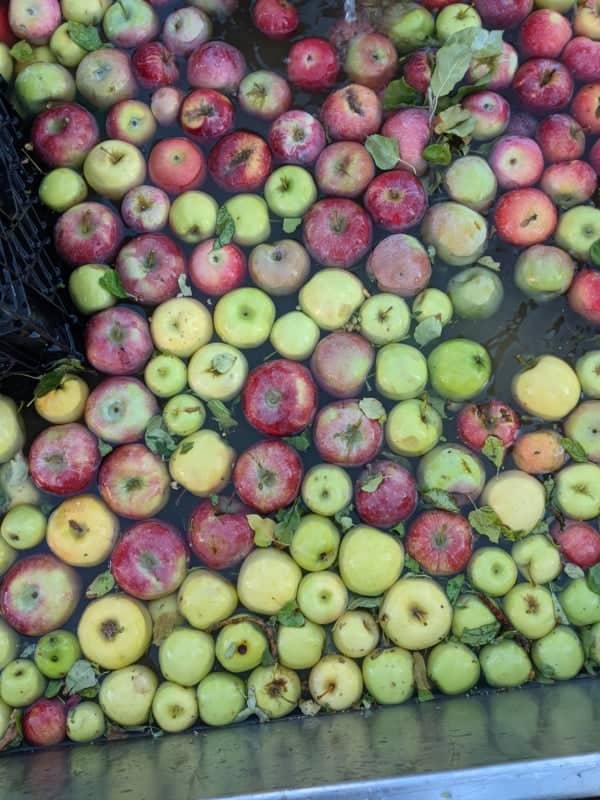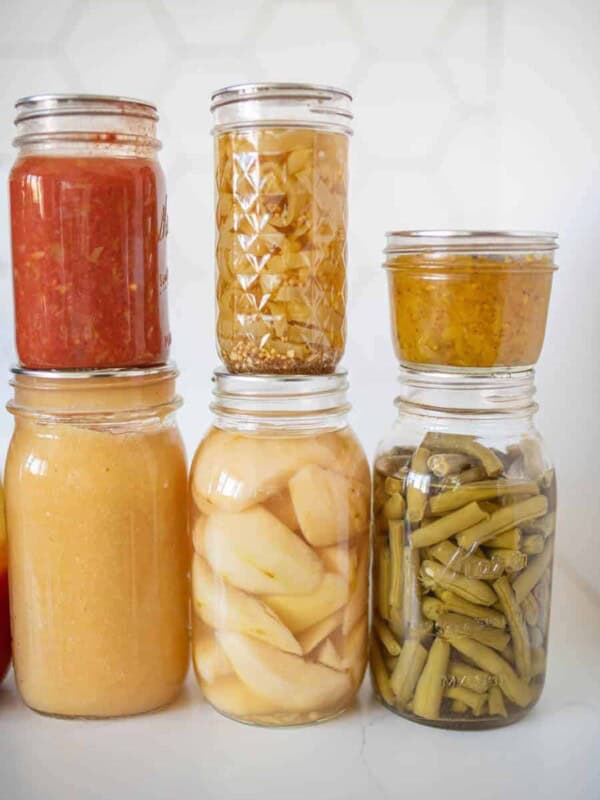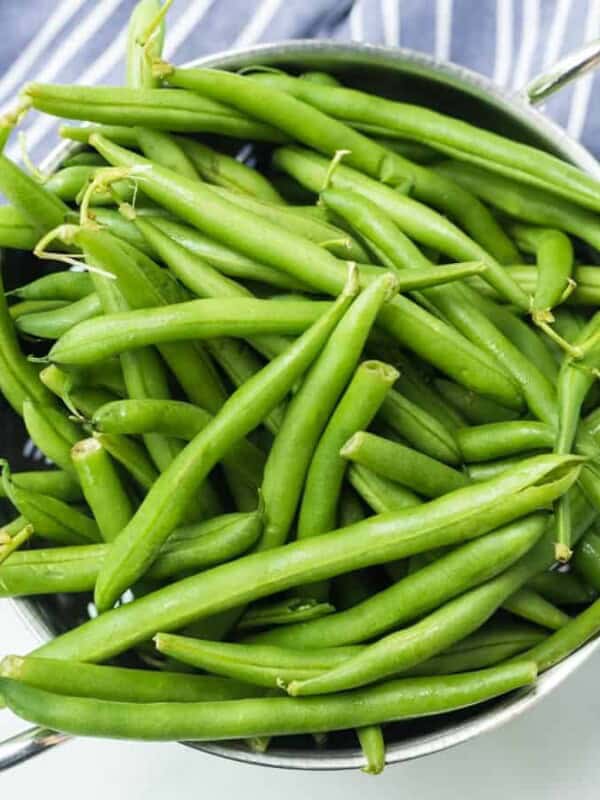Tomatillo Salsa Recipe for Canning
on Sep 24, 2020, Updated May 27, 2024
This post may contain affiliate links. Please read our disclosure policy.
Tomatillo Salsa is a fun change from traditional salsa made with tomatoes. Sure, you can buy salsa verde at the store, but it is so much tastier when you make it at home. This recipe is specifically for canning with a hot water bath – no pressure cooker needed!
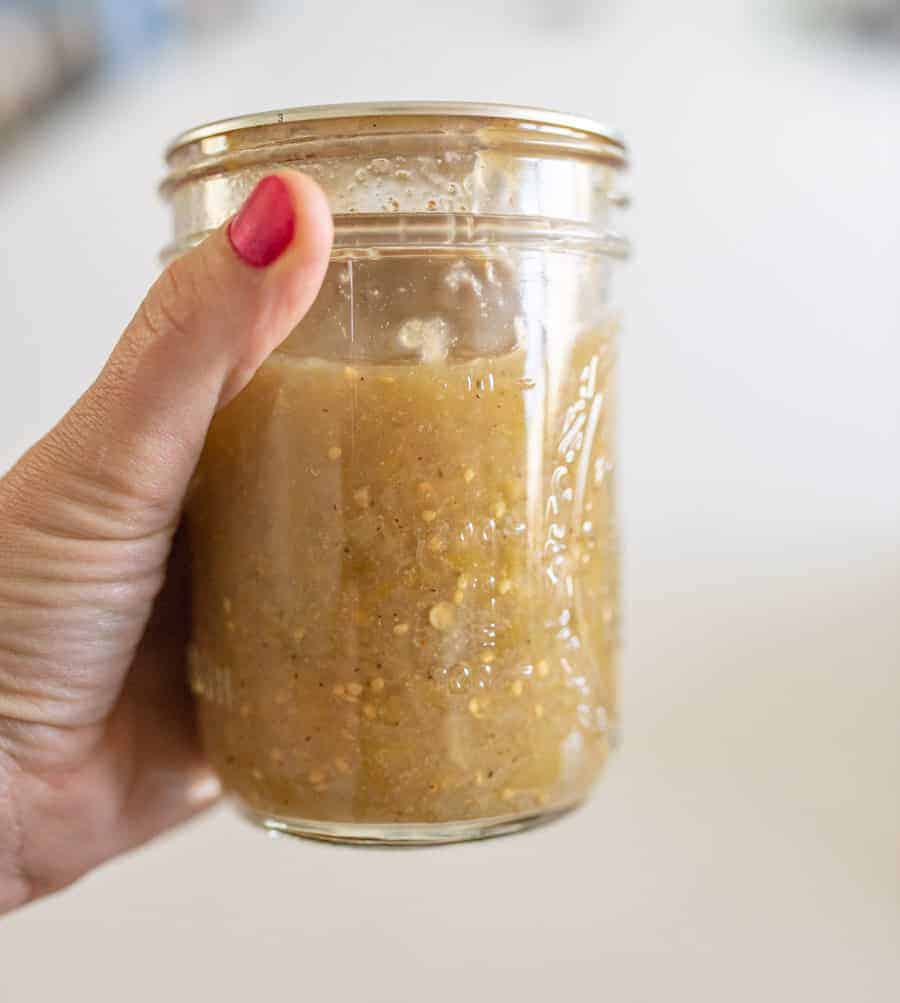
Tomatillos are a cute, little green vegetable with amazing flavor. They are native to Mexico and can be found in most grocery stores in the United States.
Salsa verde is delicious on steak fajitas, chicken enchilada casserole, or used as a marinade in a crockpot or simply chips and dip! This green salsa also happens to be a secret ingredient in my favorite chili recipe.
Table of Contents
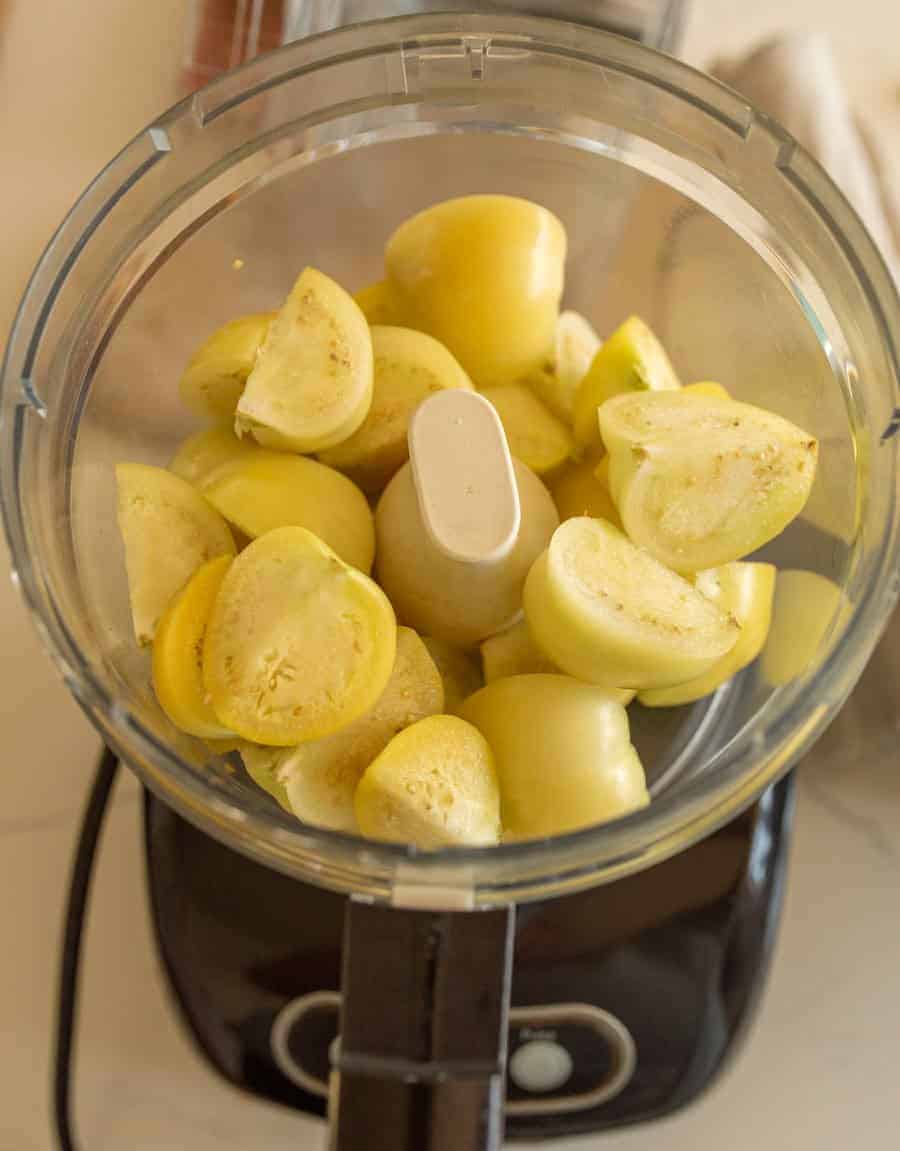
Why You’ll Love This Recipe
- Great way to preserve some of your garden harvest.
- It involves the hot water bath canning method – no pressure cooking required!
- A wonderful addition to any Mexican-inspired dish – tacos, fajitas, burritos, and more.
Important Safety Note
This recipe is from the National Center for Home Preservation and is an approved recipe for canning. DO NOT adjust measurements in this recipe. To make it shelf staple the pH of the recipe needs to be correct and adjusting ingredients will change the pH. When it comes to canning, using approved recipes from approved sources is safest.
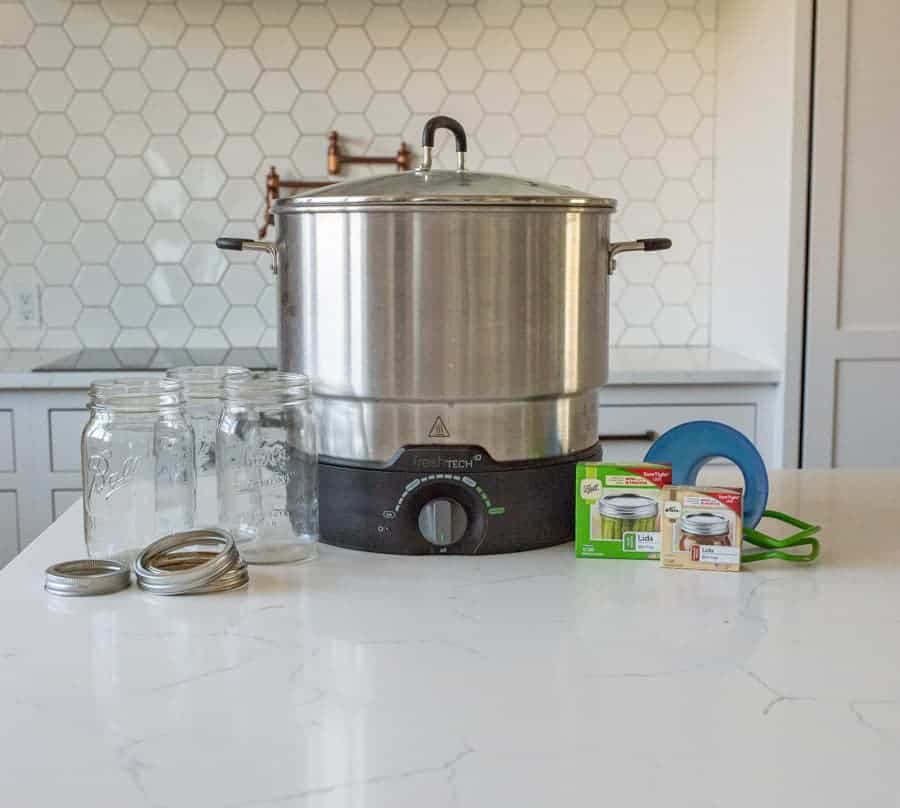
Recipe Ingredients and Supplies
- Tomatillos
- Long green chilies: Anaheim or banana peppers both work well in this recipe.
- Jalapeño peppers
- Onions
- Bottled lemon juice: Bottled lemon juice ensures that the salsa has the right pH level for safe storage.
- Garlic
- Seasonings: Ground cumin, salt, and black pepper.
- Hot water bath canner: The Ball Fresh Tech Electric Canner is what I have and absolutely love to use for hot water bath canning.
- Large stockpot
- Pint mason jars with lids: This recipe makes about 5 pints.
- Gloves: Or some other type of hand protection for handling the hot peppers.
See the recipe card below for full information on ingredients and quantities.
How to Make Tomatillo Salsa for Canning
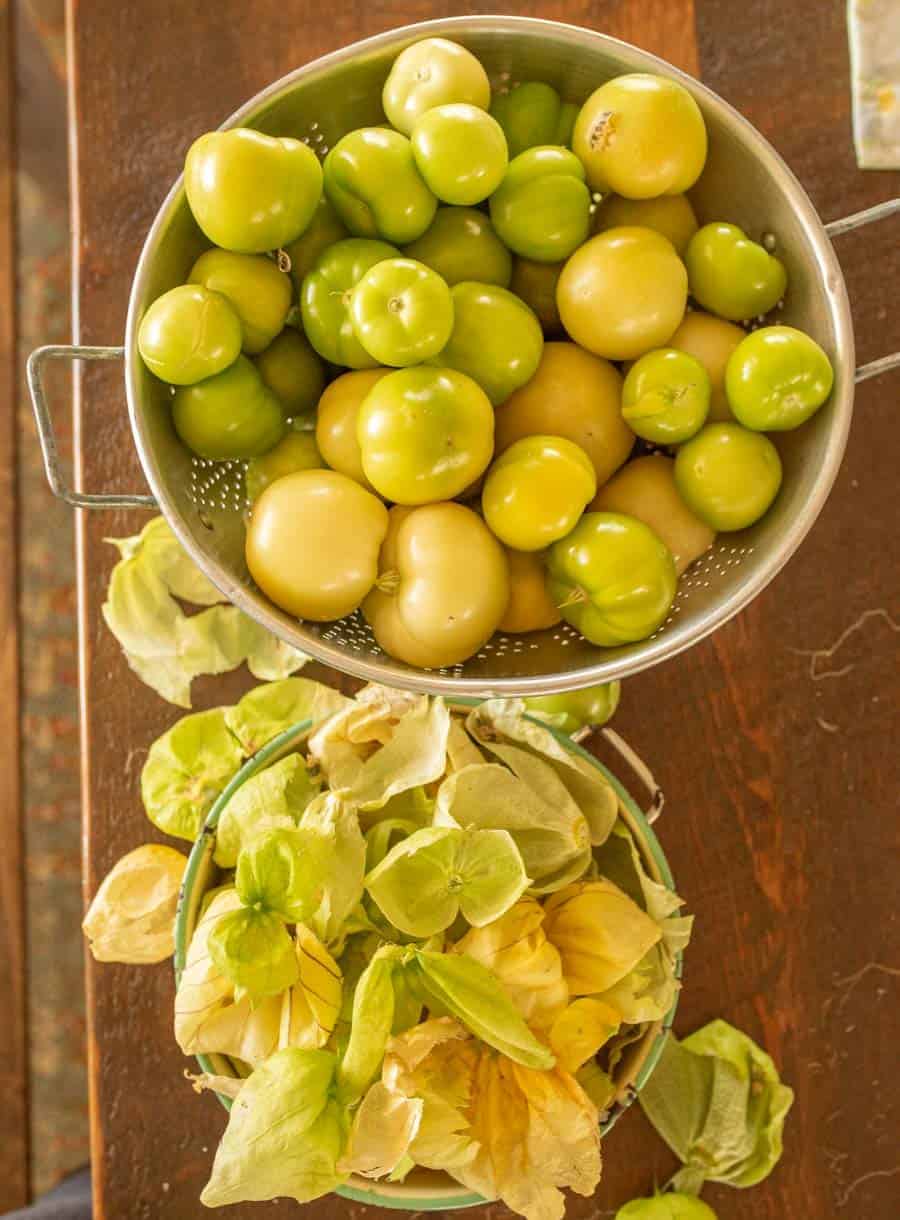
Step #1. Prepare the ingredients: Remove the husks from the tomatillos and wash them. Finely chop the peppers, jalapeños, and garlic. Dice the onions.
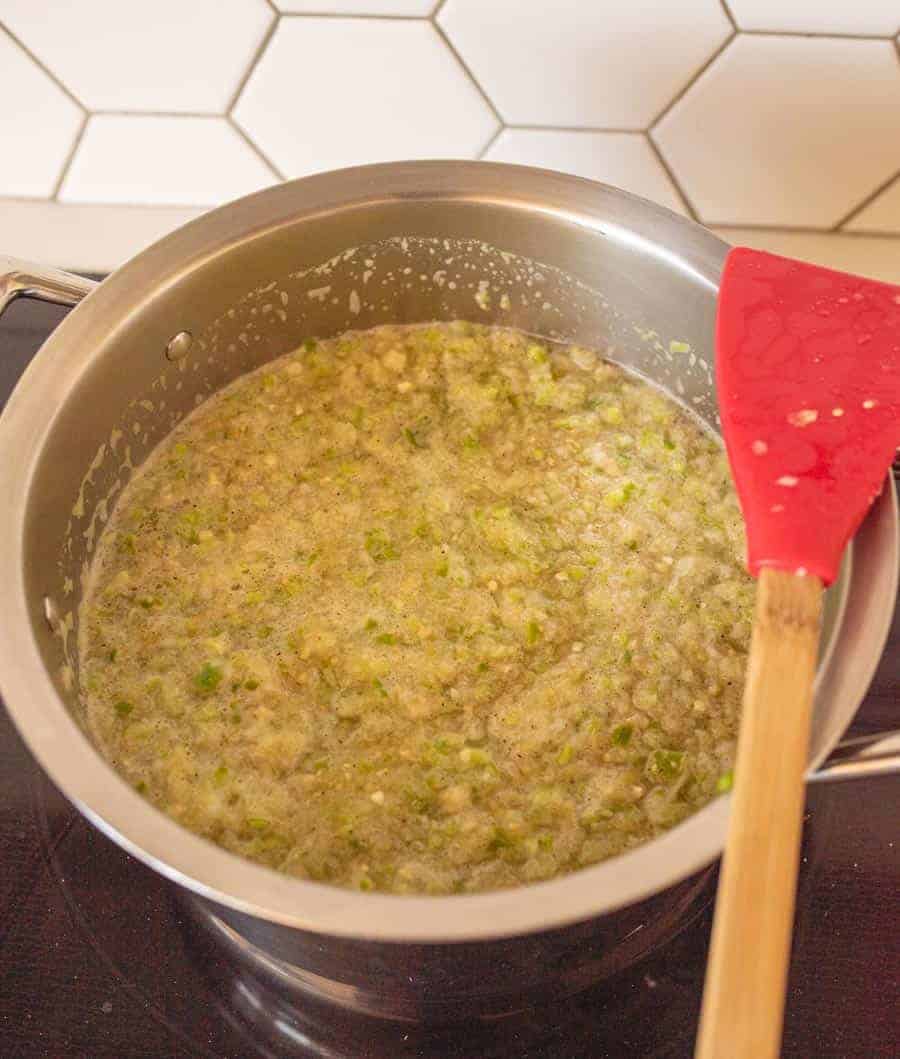
Step #2. Put all of the ingredients and seasoning in a large stock pot, bring to boil, and then simmer for 20 minutes stirring occasionally.

Step #3. Ladle the hot salsa into the Mason jars, remove the air bubbles, apply the lids, and place in a water bath canner, and boil for 15 minutes (see recipe notes for altitude adjustments).
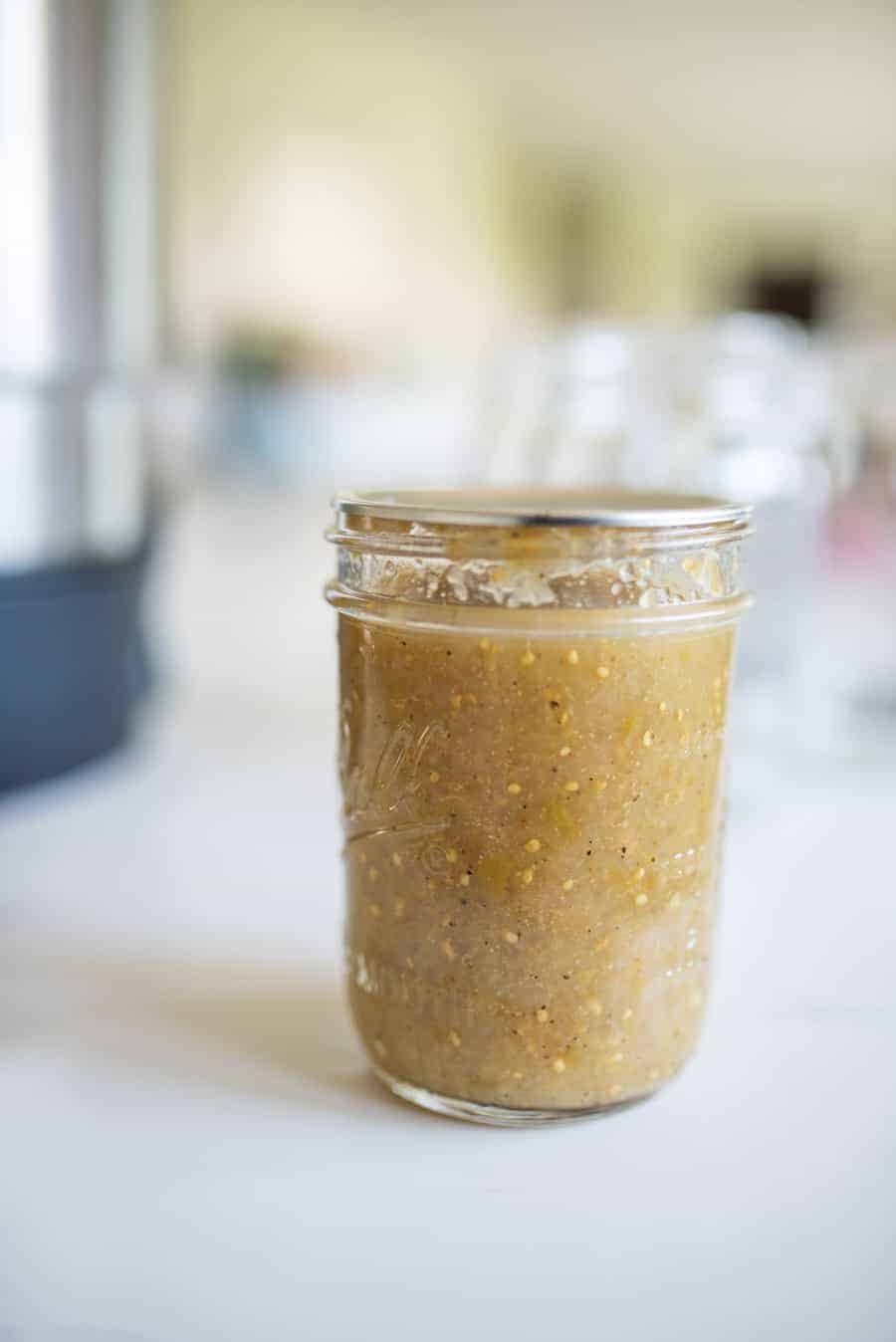
Step #4. When boiling time is complete, turn off the canner. Remove the jars when the water has stopped boiling. Once cool, remove the rings and move to their storage place.
Recipe FAQs
Yes! Salsa verde means green salsa in English and is made with tomatillos. It’s usually more mild than red salsa. However, this recipe can be a nice medium depending on how hot your peppers are.
No. Tomatillos come from a different plant that is distantly related to the tomato plant. Tomatillos are the fruit of a nightshade plant that look like small green tomatoes with inedible paper husks.
Adding lemon juice ensures that the right pH level is reached for safe storage. For canning in a hot water bath, the pH of the food must be 4.6 or lower (acidic). Read more here.
This salsa needs to be stored in the refrigerator after opening. As long as the jars remain sealed and stored properly, they will be shelf stable for up to a year.
To make it shelf-stable the pH of the recipe needs to be correct and adjusting ingredients will change the pH. It’s important to use approved recipes from a safe source. This recipe was developed by the National Center for Home Preservation.
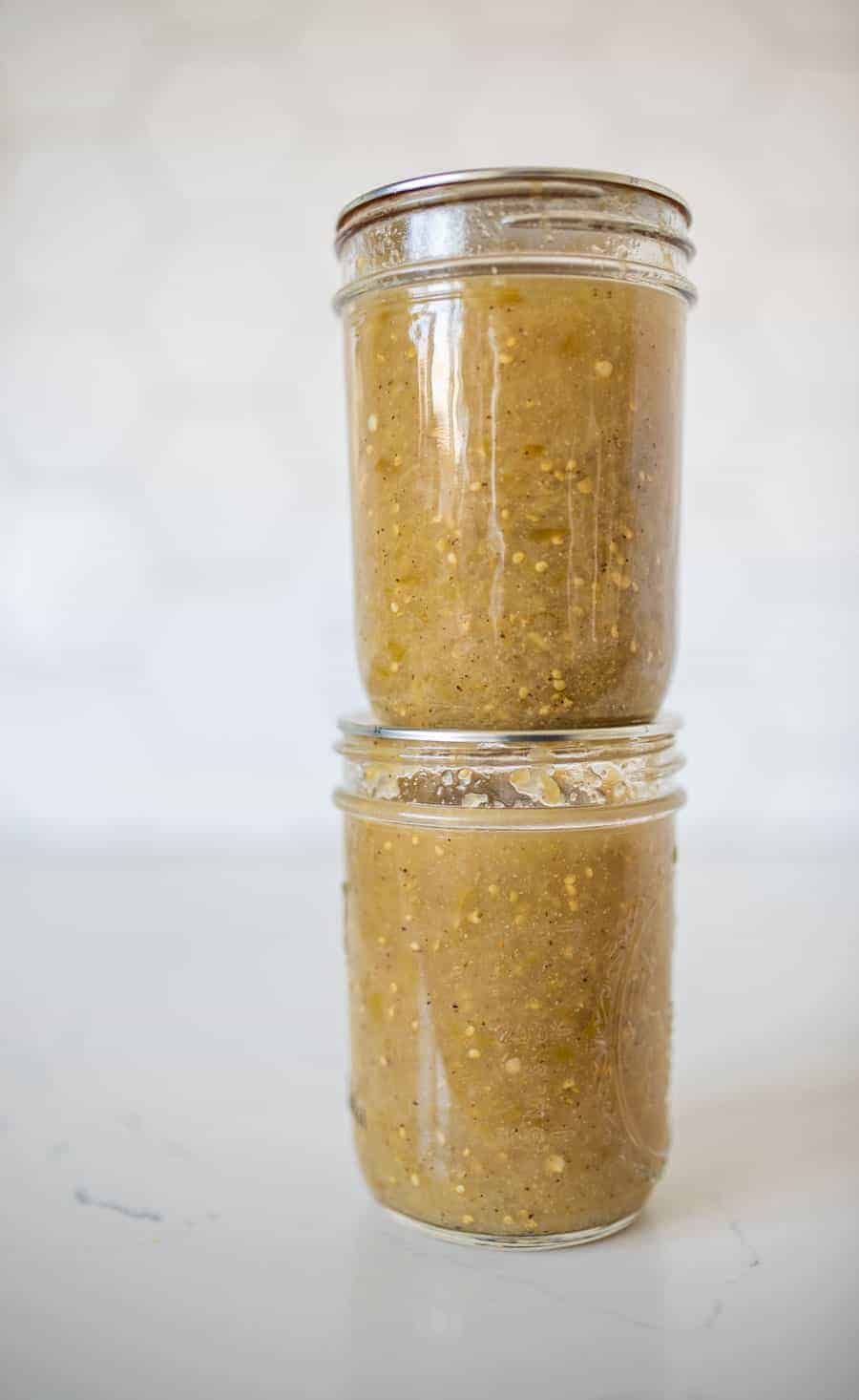
Expert Tips
- To save some time, throw the vegetables in a food processor and pulse a few times to chop or finely dice – pulse a few times for chopped and a few more for the finely diced ingredients.
- If you want this salsa to have medium heat instead of mild, don’t remove the jalapeño seeds.
- Don’t skip labeling your jars with the contents as well as the month and year because canned tomatillo salsa is safe for up to a year.
- If you grow your own, be mindful that tomatillos will reseed themselves.
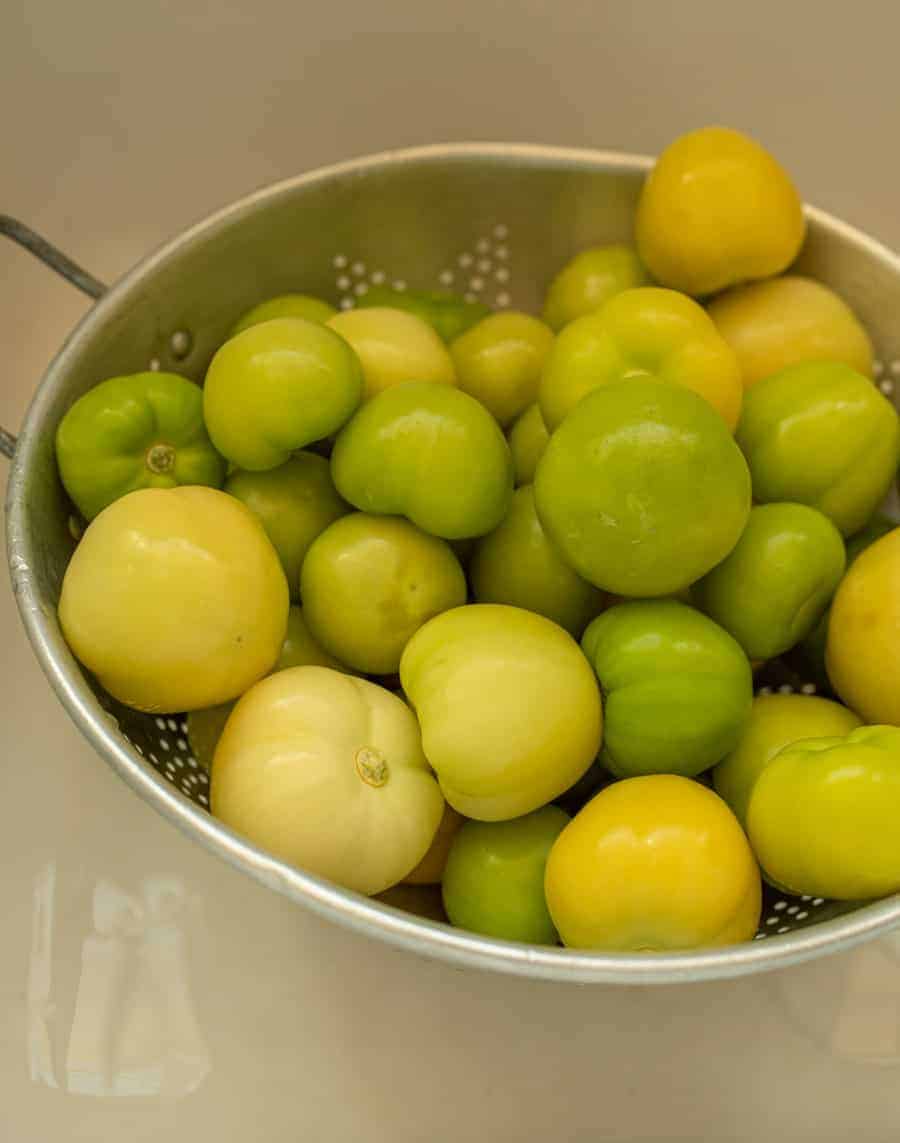
How to Store Tomatillo Salsa
It’s recommended that canned salsa is stored in a cool dark place.
If stored properly the salsa should last up to 1 year. It can last longer than that, but using within a year is the recommended time frame.
Once the jars are opened, the salsa should be stored in the refrigerator.
More Preserving Recipes to Consider
Preserving Guide
How To Preserve Apricots
Preserving Guide
How To Preserve Apples
Canning Recipes
How to Can Food: Learn the Basics
Freezing Foods
How to Blanch Green Beans
Did you make this recipe? Leave a ⭐️ review and share it on Instagram, Facebook, or Pinterest!
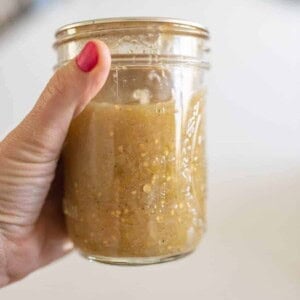
Tomatillo Salsa Recipe for Canning
Ingredients
- 5 cups tomatillos, chopped
- 1-½ cups long green chilies , (such as Anaheim or banana peppers), chopped and seeded
- ½ cup jalapeño peppers, seeded and finely chopped
- 4 cups onions, chopped
- 1 cup bottled lemon juice
- 6 cloves garlic, finely chopped
- 2 tablespoons ground cumin
- 1 tablespoon salt
- 1 teaspoon black pepper
Instructions
- Prep the tomatillos by taking off their husks and then washing them. Don’t worry about peeling or seeding them.
- Prep the peppers. At this point, make sure you are wearing hand protection. Chop the chilies finely. If you are noticing that the skin of the chilies is tough, you can heat them up in the oven until the skin starts to blister – usually about 6 minutes at 400 degrees F. To make peeling the skin easier, place the chilies in a pot and cover with a damp cloth. Let them cool and the skins should slide right off.
- Finely dice the jalapeños peppers. There is no need to peel the jalapeños. If you are looking to increase the spiciness, you can keep the seeds.
- In a large stock pot, add the chopped tomatillos, chopped chilies, chopped jalapeños, chopped onions, lemon juice, garlic, cumin, salt, and pepper. Stir to combine.
- Bring the mixture to a boil. Once boiling, reduce heat and simmer for 20 minutes stirring periodically.
- Ladle the hot salsa mixture into clean and sanitized pint Mason jars.
- Make sure to leave about 1/2-inch space at the top of the jar. Remove all of the air bubbles by gently tapping the jars on a thick towel set on your counter to help them come to the surface. Then, wipe the mouths of the jars with a clean, damp cloth.
- Apply the two-part lid and screw the ring or band on.
- Place the jars in a water bath canner filled halfway with hot tap water. Once all of the jars are in the canner, fill the canner up with more hot water until the water is 1 to 2 inches over the top of the jars.
- Bring the canner to a boil. Once the water is fully boiling, boil for 15 minutes (see notes on altitude adjustments).
- Once the 15 minutes has passed, turn the heat off your canner. When the water stops boiling, remove the hot jars from the water and place them on a cutting board or on a thick towel (taking care not to bump them together when setting them down) to cool.
- Once cooled, remove the rings for storage. Write what's in the jar and the date on the top of the lid. Store for up to a year on the shelf (they'll last longer than that but a year is ideal).
Notes
- The boiling time of 15 minutes is for altitudes of less than 1000 feet above sea level. If you live at 1000-6000 feet above sea level, boil for 20 minutes. And if you live above 6000 feet, boil for 25 minutes.
- Even with wearing gloves when handling the hot peppers, be sure to wash your hands thoroughly when you are finished.
- Using hot tap water for the water bath is important because the shock of cold water could cause the glass Mason jars to break.
- This recipe is from the National Center for Home Preservation and is an approved recipe for canning. DO NOT adjust measurements in this recipe. To make it shelf stable the pH of the recipe needs to be correct and adjusting ingredients will change the pH. When it comes to canning, using approved recipes from approved sources is safest.

